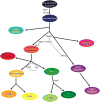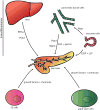Promoting ectopic pancreatic fates: pancreas development and future diabetes therapies
- PMID: 18783407
- PMCID: PMC4025910
- DOI: 10.1111/j.1399-0004.2008.01081.x
Promoting ectopic pancreatic fates: pancreas development and future diabetes therapies
Abstract
Diabetes is a disease that could be treated more effectively with a better understanding of pancreas development. This review examines the role of master regulator genes driving crucial steps in pancreas development, from foregut specification to differentiation of the five endocrine cell types. The roles of Pdx1, Ptf1a, and Ngn3 are particularly examined as they are both necessary and sufficient for promoting pancreatic cell fates (Pdx1, Ptf1a) and endocrine cell development (Ngn3). The roles of Arx and Pax4 are studied as they compose part of the regulatory mechanism balancing development of different types of endocrine cells within the iselts and promote the development of alpha/PP and beta/delta cell progenitors, respectively. The roles of the aforementioned genes, and the consequences of misexpression of them for functionality of the pancreas, are examined through recent studies in model organisms, particularly Xenopus and zebrafish. Recent developments in cell replacement therapy research are also covered, concentrating on stem cell research (coaxing both adult and embryonic stem cells toward a beta cell fate) and transdifferentiation (generating beta cells from other differentiated cell types).
Figures


Similar articles
-
Pdx-1 and Ptf1a concurrently determine fate specification of pancreatic multipotent progenitor cells.Dev Biol. 2008 Apr 1;316(1):74-86. doi: 10.1016/j.ydbio.2008.01.011. Epub 2008 Jan 26. Dev Biol. 2008. PMID: 18294628 Free PMC article.
-
neurogenin3 is required for the development of the four endocrine cell lineages of the pancreas.Proc Natl Acad Sci U S A. 2000 Feb 15;97(4):1607-11. doi: 10.1073/pnas.97.4.1607. Proc Natl Acad Sci U S A. 2000. PMID: 10677506 Free PMC article.
-
Ectopic Ptf1a expression in murine ESCs potentiates endocrine differentiation and models pancreas development in vitro.Stem Cells. 2014 May;32(5):1195-207. doi: 10.1002/stem.1616. Stem Cells. 2014. PMID: 24375815 Free PMC article.
-
Specifying pancreatic endocrine cell fates.Mech Dev. 2006 Jul;123(7):501-12. doi: 10.1016/j.mod.2006.05.006. Epub 2006 May 25. Mech Dev. 2006. PMID: 16822656 Review.
-
Generation of insulin-producing cells from pluripotent stem cells: from the selection of cell sources to the optimization of protocols.Rev Diabet Stud. 2010 Summer;7(2):82-92. doi: 10.1900/RDS.2010.7.82. Epub 2010 Aug 10. Rev Diabet Stud. 2010. PMID: 21060967 Free PMC article. Review.
Cited by
-
Xenopus insm1 is essential for gastrointestinal and pancreatic endocrine cell development.Dev Dyn. 2009 Oct;238(10):2505-10. doi: 10.1002/dvdy.22071. Dev Dyn. 2009. PMID: 19705447 Free PMC article.
-
Challenges for molecular diagnosis of familial early-onset diabetes in unexplored populations.Iran J Public Health. 2014 Jul;43(7):1011-3. Iran J Public Health. 2014. PMID: 25909071 Free PMC article. No abstract available.
-
The tetraspanin Tm4sf3 is localized to the ventral pancreas and regulates fusion of the dorsal and ventral pancreatic buds.Development. 2009 Jun;136(11):1791-800. doi: 10.1242/dev.032235. Epub 2009 Apr 29. Development. 2009. PMID: 19403659 Free PMC article.
-
Small-molecule inducers of insulin expression in pancreatic alpha-cells.Proc Natl Acad Sci U S A. 2010 Aug 24;107(34):15099-104. doi: 10.1073/pnas.1010018107. Epub 2010 Aug 9. Proc Natl Acad Sci U S A. 2010. PMID: 20696901 Free PMC article.
-
Transient expression of Ngn3 in Xenopus endoderm promotes early and ectopic development of pancreatic beta and delta cells.Genesis. 2012 Mar;50(3):271-85. doi: 10.1002/dvg.20828. Epub 2012 Jan 30. Genesis. 2012. PMID: 22121111 Free PMC article.
References
-
- Jensen J. Gene regulatory factors in pancreatic development. Dev Dyn. 2004;229:176–200. - PubMed
-
- Murtaugh LC. Pancreas and beta-cell development: from the actual to the possible. Development. 2007;134:427–438. - PubMed
-
- Cano DA, Hebrok M, Zenker M. Pancreatic development and disease. Gastroenterology. 2007;132:745–762. - PubMed
-
- Kelly OG, Melton DA. Development of the pancreas in Xenopus laevis. Dev Dyn. 2000;218:615–627. - PubMed
Publication types
MeSH terms
Substances
Grants and funding
LinkOut - more resources
Full Text Sources
Other Literature Sources
Medical
Miscellaneous

